*NURSING > STUDY GUIDE > NURSING 220 MATERNITY HESI 6 STUDY GUIDE,100% CORRECT (All)
NURSING 220 MATERNITY HESI 6 STUDY GUIDE,100% CORRECT
Document Content and Description Below
1. One week after missing her menstrual period, a woman performs an OTC pregnancy test and it is positive. Which hormone is responsible for producing the positive result? 2. The father of a 3-day o... ld infant who is breast feeding calls the postpartum help line to report that his wife is acting strangely. She is irritable, cannot cope with the baby, and frequently cries for no apparent reason. What information is most important for the nurse to provide this father? 3. After amniocentesis monitor for signs of labor, since it increases the risk 4. Clients who are HIV positive are encouraged to bottle-feed their infants because: 5. When fetal movements or contractions compress the umbilical cord, variable decelerations can happen. 6. PKU- prenatal history. When both parents are carriers of an autosomal recessive gene, such as PKU, each child has a 25% change of being healthy. 7. A primigravida at 36 weeks gestation, who is Rh negative, experienced abdominal trauma in a motor vehicle collision. Which assessment finding is more important for the nurse to report to the HCP? 8. Calculated by Naegele’s rule, a primigravida client is at 28 weeks gestation. She is moderately obese and carrying twins and the nurse measures her fundal height at 27 cm. During the previous visit 3 weeks ago, the fundal height measured at 28 cm. Based on these findings, what should the nurse conclude? 9. The nurse is discussing involution with a postpartum client. Which statement best indicates that the client understands the effect of breastfeeding on the resumption of menstrual cycle? 10. A term multigravida who is receiving oxytocin (Pitocin) for labor augmentation, is requesting pain medication. Review of the client’s record indicates that she was medicated 30 minutes ago with butorphanol (Stadol) 2 mg and promethazine (Phenergan) 25 mg IV push. Vaginal exam reveals that the clients cervical dilation is 3 cm, 70% effaced, and at a 0 station. What action should the nurse implement? 11. While caring for a laboring client on continuous fetal monitoring. The nurse notes an FHR pattern that falls and rises abruptly with a “V” shaped appearance. What action should the nurse take first? 12. During the admission of a newborn, the nurse identifies a localized swelling that does not cross the suture line on the posterior area of the parietal bone. What action should the nurse implement? 13. The nurse is teaching a client with gestational diabetes about nutrition and insulin need for pregnancy. Which content should the nurse include in this client teaching plan? 14. A 38-week primigravida client who is positive for group A beta streptococcus receives a prescription for cefazolin 2grams IV to be infused over 30mins. The medications available in 2 grams/100ml of normal saline. The nurse should program the infusion pump to deliver how many ml/hours? 15. When performing daily head to toe assessment of a 1-day old newborn the nurse observes yellow tint to the skin on the forehead, sternum and abdomen. What action should the nurse take? a. measure bilirubin levels using transcutaneous bilirubinometer. b. review maternal medical records for blood type and Rh factor c. Prepare the newborn for phototherapy d. Evaluate cord Coombs test results 16. A new mother asks the nurse about an area of swelling on her baby head near the posterior fontanel that lies across the suture lines. How should the nurse respond? a. That's called caput succedaneum. It will absorb and cause no problems. b. That is called a cephalhematoma. It will cause no problems. c. That is called a cephalhematoma. It can cause jaundice as it is. d. That is called caput succedaneum. It will have to be drained. 17. A 39-week gestational multigravida is admitted to labor and delivery spontaneous rupture of membranes and contraction occurring 2 to 3 minutes. A vaginal exam indicates that the cervix is dilated 6cm, 90% effaced and the fetus is at a +2 station. During the last 45 minutes the fetal heart rate has ranged between 170 and 180 beats/minute. What action should the nurse implement? a. Obtain a blood specimen for hemoglobin b. Take an oral maternal temperature c. Straight Catheterize client d. Send amniotic fluid for analysis 18. An obviously pregnant woman walks into the hospital’s emergency department entrance shouting. “Help me! Help me! My baby is coming! Im so afraid!” The nurse determines if delivery is indeed imminent, what action is most important for the nurse to take? a. Determines the gestational age of fetus b. Assess the amount and color of the amniotic fluid c. Obtain peripheral IV access and begin administration of IV fluids d. Provide clear concise instructions in a calm, deliberate manner 19. A client who is 3 weeks postpartum tells the nurse. “I am so tired all the time. I didn't know having a baby would be so hard.” What response should the nurse provide. a. It is common to feel exhausted for the first 3 months. Try to sleep when the baby sleeps. b. It is normal to feel tired for the first couple weeks. Be patient with yourself and rest more. c. You should not be doing any housework. Are any of your family members helping you? d. Adjusting to a new baby can be difficult. Tell me more about any help you are receiving. 20. The home health nurse visits a client who delivered a full-term baby three days ago. The mother reports that the infant is waking up every 2 hours to bottle feed. The nurse notes white, curl-like patches on the newborns oral mucous membranes. What action should the nurse implement? a. Discuss the need for medication to treat curl-like oral patches b. Suggest switching the infant’s formula c. Assess the baby’s blood glucose level d. Remind mother not put the baby to bed with a propped bottle 21. One hour after delivery the nurse is unable to palpate the uterine funds of a client who had an epidural and notes a large amount of lochia on the perineal pad. The nurse massages at the umbilicus and obtains current vital signs. Which intervention should the nurse implement next. a. Document number of pad changes in the last hour b. Provide bedpans to void if unable to ambulate c. Palpate the supra cubic area for bladder distention d. Increases the rate of the oxytocin infusion 22. The father of a 3-day old infant who is breast feeding calls the postpartum help line to report that his wife is acting strangely. She is irritable, cannot cope with the baby, and frequently cries for no appeared reason. What information is most important for the nurse to provide the father? a. Contact the clinic if the behaviors continue for more than two weeks or becomes worse b. Tell the father count the newborns number of soiled diapers over the next few days. c. A fluctuation in hormones in the early postpartum period can cause mood changes. d. Recommend giving supplemental bottle feedings to the baby between breast feeding. 23. Which action should the nurse take if an infant, who was born yesterday weighing 7.5lbs (3,317grams) weights 7 lbs. (3,175grams) today. a. Monitor the stool and urine output of the neonate for the last 24 hours b. Inform and assure the mother that this is a normal weight loss c. Encourages the mother to increase frequency of breastfeeding. d. After verifying the accuracy of the weight, notify the healthcare provider. 24. A term multigravida, who is receiving oxytocin for labor augmentation is requesting pain medication. Review of the clients record indication that she was medicated 30minutes ago with butorphanol (Stadol) 2mg and promethazine (Phenergan) 25mg IV push. Vaginal examination reveals that the client cervical dilation is 3cm, 70% effaced, and at a 0 station. What action should the nurse implement? a. Discontinue the Pitocin infusion b. Medicate the client with an additional 1mg of Stadol IV push c. Notify the healthcare provider d. Instruct the client to use deep breathing during contraction 25. A woman who delivered a 9-pound baby boy by cesarean section under spinal anesthesia is recovering in the post anesthesia care unit. Her fundus is firm at the umbilicus and a continues to trickle bright red blood with no clots from the vagina in observed by the nurse. Which actions should the nurse implemented. a. Massage the fundus b. Assess her blood pressure c. Apply ice pack to perineum d. Let the infant breast feed 26. A newborn infant is receiving immunization prior discharge. Which action should the nurse implement? a. Give the first dose of the vaccine for rotavirus if any have diarrhea now. b. Obtain signed consent from the mother for administration of hepatitis B vaccine c. Prepare the first dose for DTaP d. Ask the mother if she wants the infant immunized for 27. A new mother, who is a lacto-ovo vegetarian, plans to breastfeed her infant. What information should the nurse provide prior to discharge. 28. When teaching a gravid client how to perform kick (fetal movement) counts which instruction should the nurse includes. 29. A client at 38- weeks’ gestation complaints of severe abdominal pain. Upon the nurse notes that the abdomen is rigid. a. Placenta previa b. Oligoamnios c. Abruptio placenta d. Chorioamnionitis 30. A 26-week gestational primigravida who is carrying twins is seen in the clinic today. Her fundal height in measured at 29cm. Based on these findings what actions the nurse implement. a. Notify the healthcare provider of the finding b. Document the finding in the medical record c. Schedule the client for a biophysical profile d. Request another nurse measure the fundus 31. The nurse is performing a newborn assessment. Which symptoms if present in newborn, would indicate respiratory distress? a. Flaring of the nares 32. The nurse is caring for a laboring client who is GBS+ (Group B streptococcus). Which immediate treatment is indicated for this client? a. Administration of Pitocin b. Artificial rupture of the membrane c. Amnioinfusion for the baby d. Administration of antibodies 33. The nurse examines a client who is admitted in active labor and determines the cervix is 3cm dilated 50% effaced, and the presenting part is at 0 stations. An hour later, she tells the nurse that she wants to go to the bathroom. Which action should the nurse implement first. a. Check the pH of the vaginal fluid b. Review the fetal heart rate pattern c. Palpate the client’s bladder d. Determine cervical dilation 34. The nurse’s assessment of a preterm infant reveals decreased muscle tone, signs of respiratory difficulty, irritability, and mottled, cool skin. Which intervention should the nurse implement first? a. Position radiant warmer over the crib b. Assess the infants blood glucose level c. Nipple feed 1 ounce 1% glucose in water d. Place the infant in side-lying position 35. Which content should the nurse plan to include in a nutrition class for pregnant adolescents? (select all that apply) a. Take iron and calcium supplements daily b. Gain no more than 15 pounds during the pregnancy c. Increase food intake by 300 to 400 calorie /day d. Take folic acid supplement daily e. Maintain current protein intake 36. The healthcare provides prescribes 10units/L of oxytocin (Pitocin) via IV drips to augment a client labor because she is experiencing a prolonged active phase. Which finding would cause the nurse to immediately discontinue the oxytocin? a. uterus soft b. contraction duration of 100 seconds c. four contractions in 10 minutes d. Early deceleration of fetal heart rate 37. A new mother who is breastfeeding her 4-week old infant and has type 1 diabetes, reports that her insulins needs have decreased since the birth of her child. What action should the nurse implement? a. Inform her that a decrease for insulin occurs while breastfeeding b. Advice the client to breastfeed more frequently c. Counsel her to increase her calories retake d. Schedule an appointment for the client with diabetic nurse educator 38. A diabetic client delivers a full-term large for gestation- age (LGA) infant who is jittery action should the nurse take first? a. Obtain a blood glucose level 39. The postpartum admission prescription for a client who delivered a healthy newborn includes one liter of lactated ringers with oxytocin 20units to infuse over 8 hours. How many milliunits /minutes is the clients receiving??? 40. A pregnant, homeless woman who has received no prenatal care presents to the clinic in her third trimester because she is having vaginal bleeding but reports that she is not in pain. Ultrasound reveals a placenta previa. Which actions should the nurse implement? 41. The nurse is planning a class for pregnant women in the first trimester of pregnancy. Which information is most important for the nurse to include in the class? a. Plan rest periods and increase sleep time to an hour per day when fatigue b. If any vaginal bleeding occurs, notify the healthcare provider immediately c. Since eating often relieves nausea, carry low fat snacks to eat whenever nausea occurs d. If morning dizziness occurs, rise slowly and sit on the side of the bed for one minute 42. When assessing a pregnant woman AT 39-weeks’ gestation who is admitted to labor and delivery which finding is most important to report to the health care provider? a. + proteinuria b. 130/70 blood pressure c. + pedal edema d. 101.2 oral temperature 43. A client who suspects she is pregnant tells the nurse she has a peptic ulcer that is being treated with misoprostol (Cytotec), a synthetic prostaglandin C drug, how should the nurse respond? a. “You may be at risk for having a spontaneous miscarriage” b. “You may have an increased chance of having preeclampsia” c. “This medication will have no effect on your unborn child” d. “You may experience postpartum hemorrhaging after delivery” 44. Following the vaginal delivery of a large-for-gestation-age (LGA) infant a woman is admitted to the intensive care unit due to postpartum hemorrhaging. The client’s medical record lists have client’s religion as Jehovah’s Witness. What action should the nurse take? 45. After delivery of a normal infant, the mother tells the nurses that she would like to use oral contraceptive. Which finding in the client’s health history is a contraindication of the use of contraceptives? a. Previously used intrauterine device (IUD) b. Reported history of stroke within family c. Diagnosed with diabetes mellitus 2 years ago d. Smoked cigarettes prior to becoming pregnant 46. When planning care for a laboring client, the nurse identifies the need to withhold solids food while the client is in labored. What is the most important reasons for this nursing intervention? 47. The parents of a male newborn have signed an informed consent for circumcision. which intervention should the nurse implement upon completion of the circumcision? a. Place petroleum gauze dressings on the site b. wrap the infant in warm receiving blankets c. Give a PRN dose of liquid acetaminophen d. Offer a pacifier dipped in glucose water 48. The nurse is caring for a postpartum client who is complaining of severe pain and a feeling of pressure in her perineum. Her fundus is firm, and she has a moderate lochia flow. On inspection the nurse finds that a perineal hematoma is beginning to form. Which assessment findings show the nurse obtain first? a. Abdominal contour and bowel sounds b. Hemoglobin and hematocrit c. Heart rate and blood pressure d. Urinary output and IV fluid intake 49. At 6 weeks gestation the rubella titer of a client medication indicates she is non-immune. When is the best time to administer a rubella vaccine to this client? a. After the client stops breastfeeding b. Immediately, at 6-weeks’ gestation to protect fetus c. After the client reaches 20-weeks gestations d. Early postpartum within 72 hours of delivery 50. The nurses assessing a 38-week gestation newborn infant immediately following a vaginal birth. Which assessment finding best indication that the infant is transitioning well to extrauterine life? 51. A woman in her third trimester of pregnancy has been in active labor for the past 8 hours and cervix dialed 3cm. The nurse’s assessment findings and electronic fetal monitoring (EFM) are consistent with hypotonic dystocia, and the healthcare provider prescribes an oxytocin drip. Which data is most important for the nurse to monitor? a. Clients hourly blood pressure b. Preparation for emergency cesarean birth c. Intensity, interval, and length of contractions d. Checking the perineum for bulging 52. The nurse is caring for a newborn who is 18inches long, weighs 4 pounds, 14 ounces, has a head circumference of 13 inches, and a chest circumference of 10inches. Based on these physical findings, assessment for which condition has the highest priority? a. Hyperthermia b. Hyperbilirubinemia c. Polycythemia d. Hypoglycemia 53. A client who delivered a healthy newborn an hour ago asks the nurse when she can go home. Which information is most important for the nurse to provide the client? 54. A client who is anovulatory and has hyperprolactinemia is being treated for infertility with metformin, menotropins (Repronex, menopur), and human chorionic gonadotropin(hCG). Which side effects should the nurse tell the client to report immediately? a. Episodes of headache and irritability b. Nausea and vomiting c. Rapid increase in abdominal girth d. Persistent daytime fatigue 55. At 0600 while admitting a woman for a scheduled repeat Caesarean section (C-section), the client tells the nurse that she drank a cup of coffee at 0400 because she wanted to avoid getting a headache. Which action should the nurse take first? 56. Following the vaginal delivery of a 10-pound infant, the nurse assesses a new mothers vaginal bleeding and finds that she has saturated two pads in 30minutes and has a boggy uterus. What action should the nurse implement first? 57. A client at 20 weeks gestation comes to antepartal clinic complaining of vaginal warts (human papilloma virus HPV). What information should the nurse provide this client? 58. A 33-year-old client at 9 weeks gestation tells the nurse that while she has “cut down,” she still has at least one alcoholic drink every evening before bedtime. What intervention should the nurse implement? a. Notify child protective services of the client’s illicit drug use and probable child endangerment b. Praise the client for her actions and offer to discuss ways to decrease consumption even more c. Insist that the client stop all alcohol use and draw a blood alcohol level at each prenatal visit [Show More]
Last updated: 1 year ago
Preview 1 out of 10 pages
.png)
Reviews( 0 )
Document information
Connected school, study & course
About the document
Uploaded On
Nov 18, 2020
Number of pages
10
Written in
Additional information
This document has been written for:
Uploaded
Nov 18, 2020
Downloads
0
Views
65

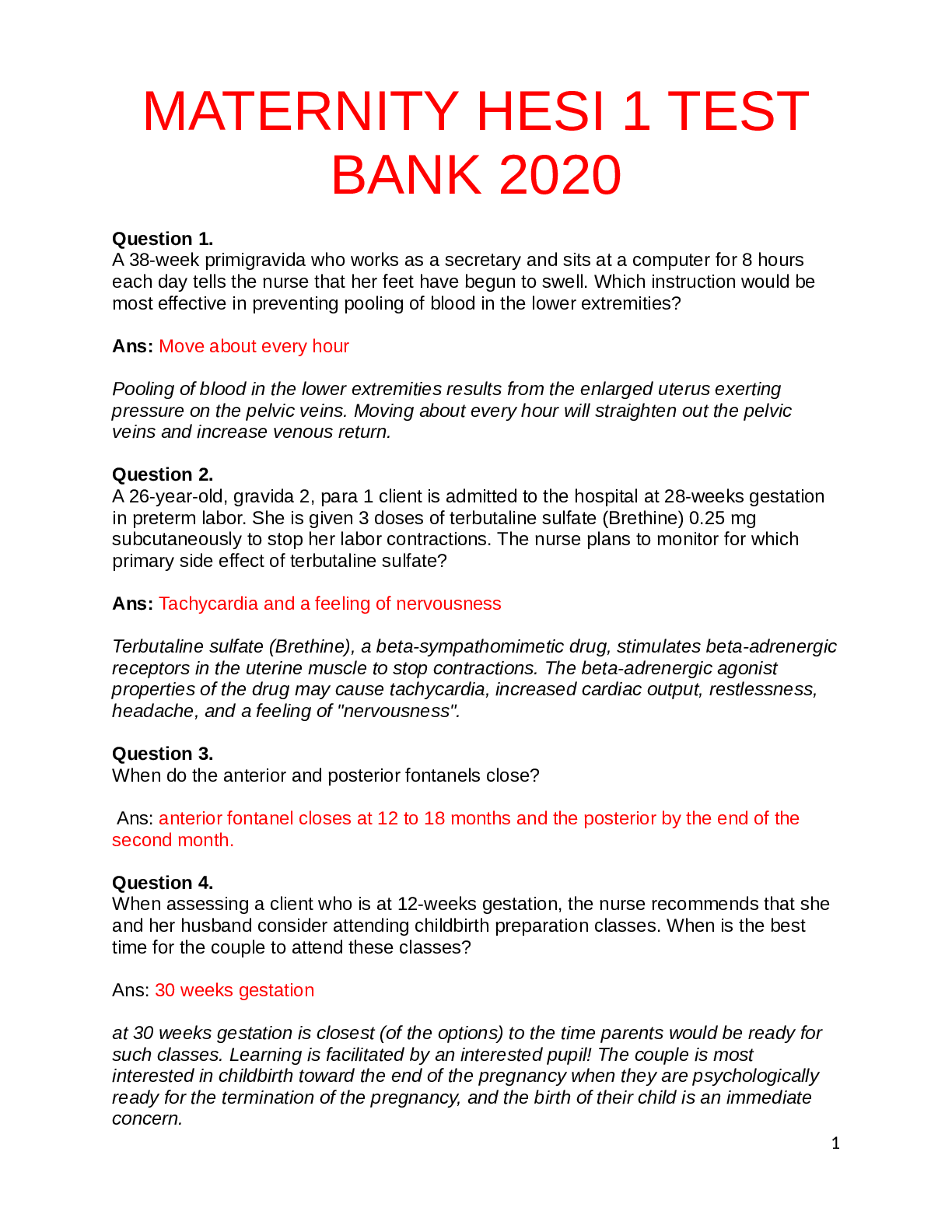
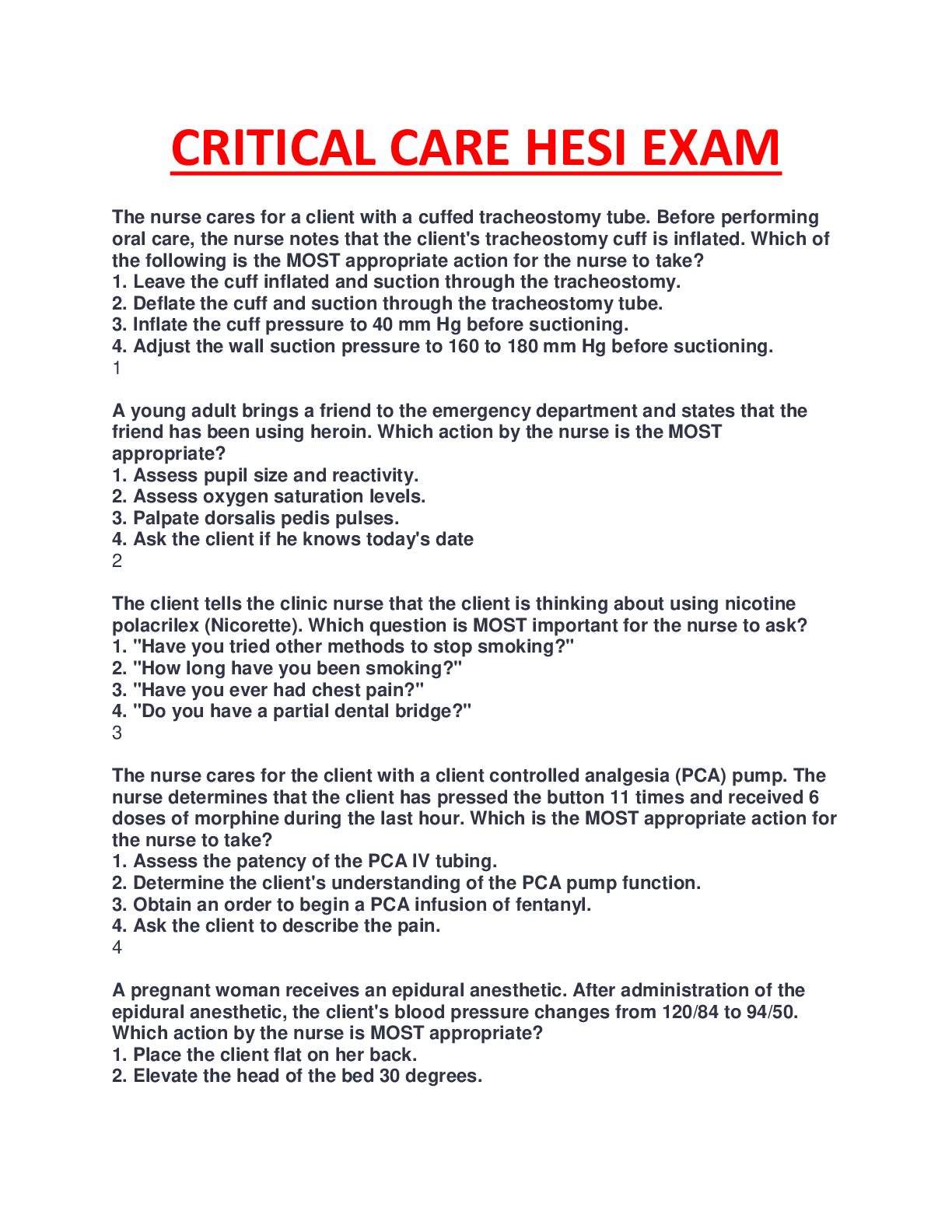
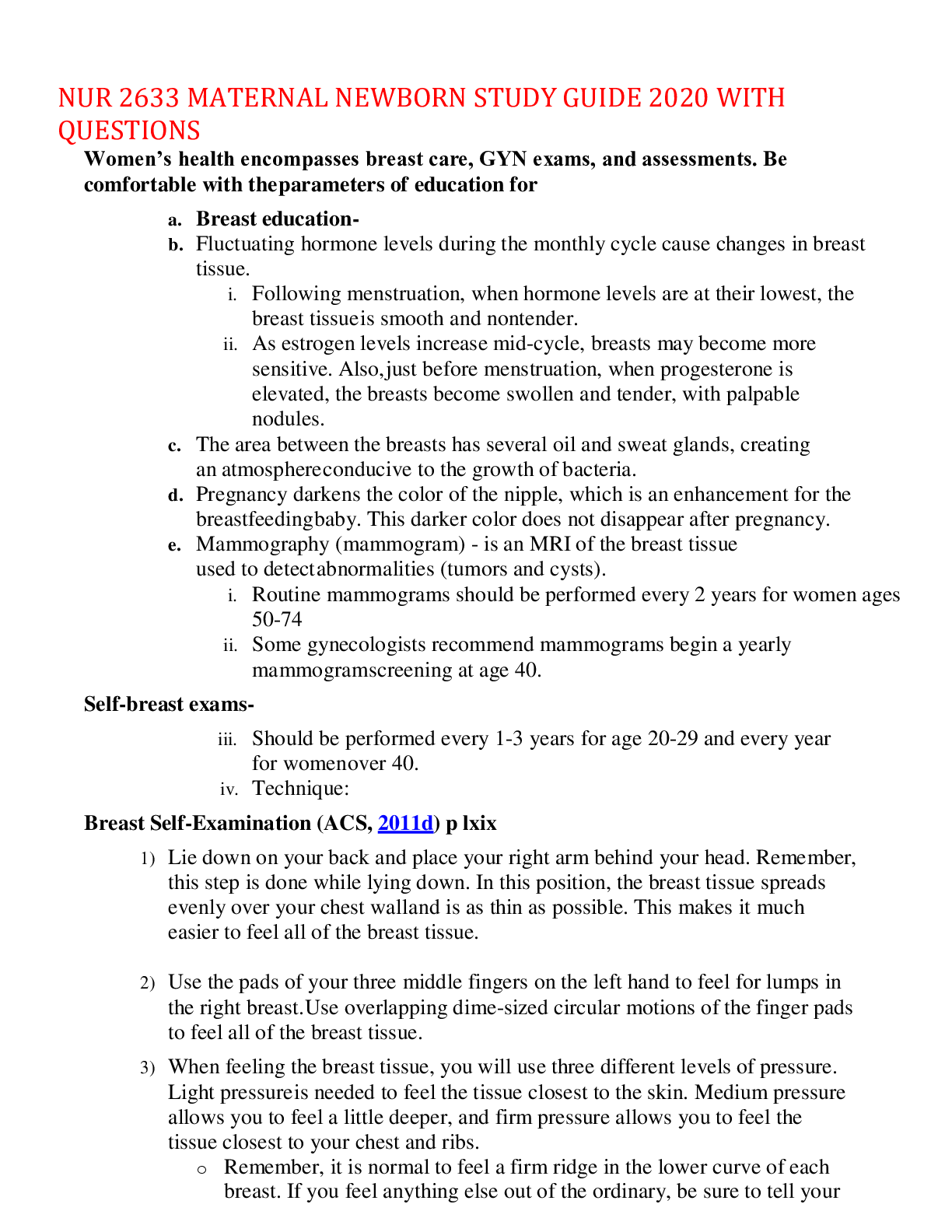
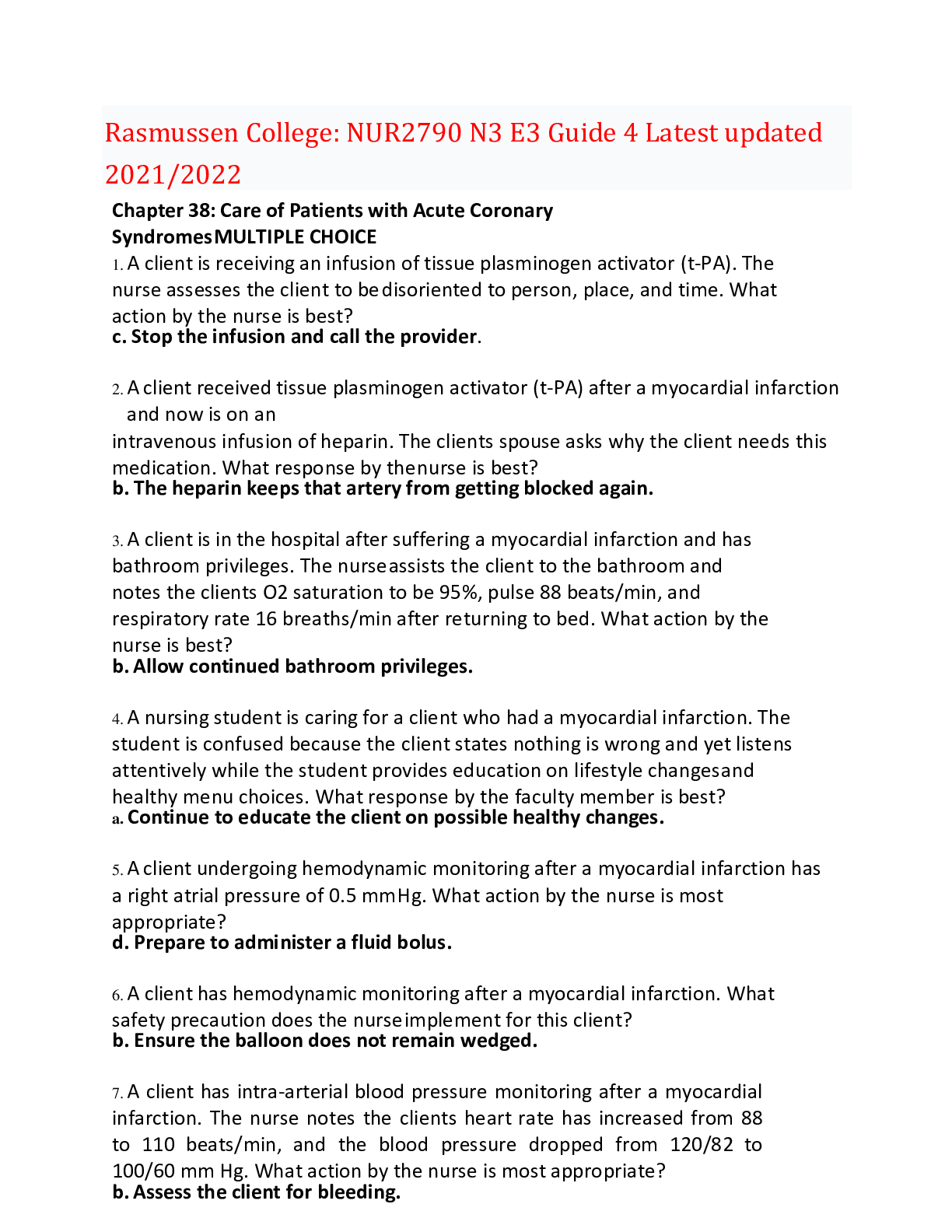

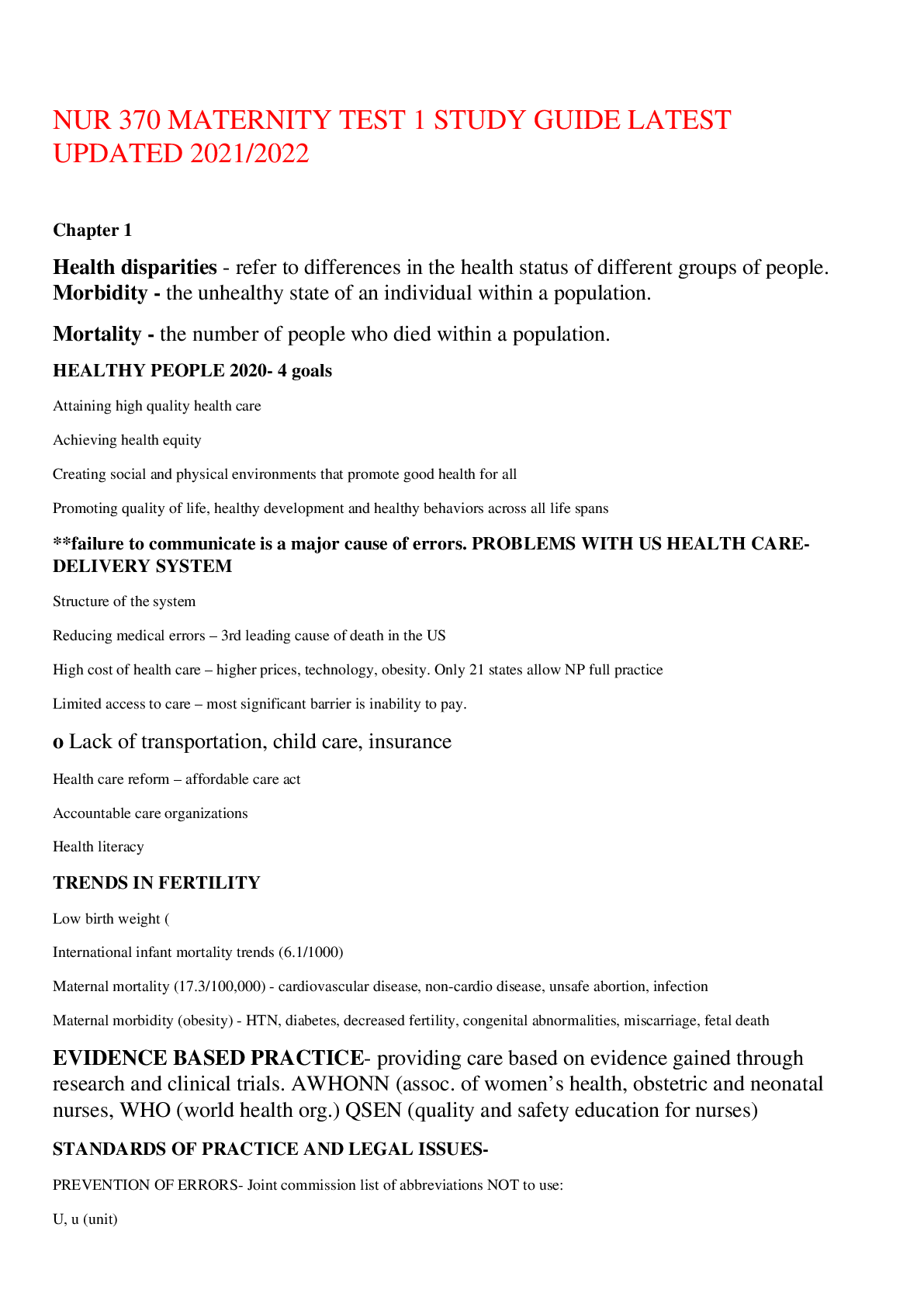
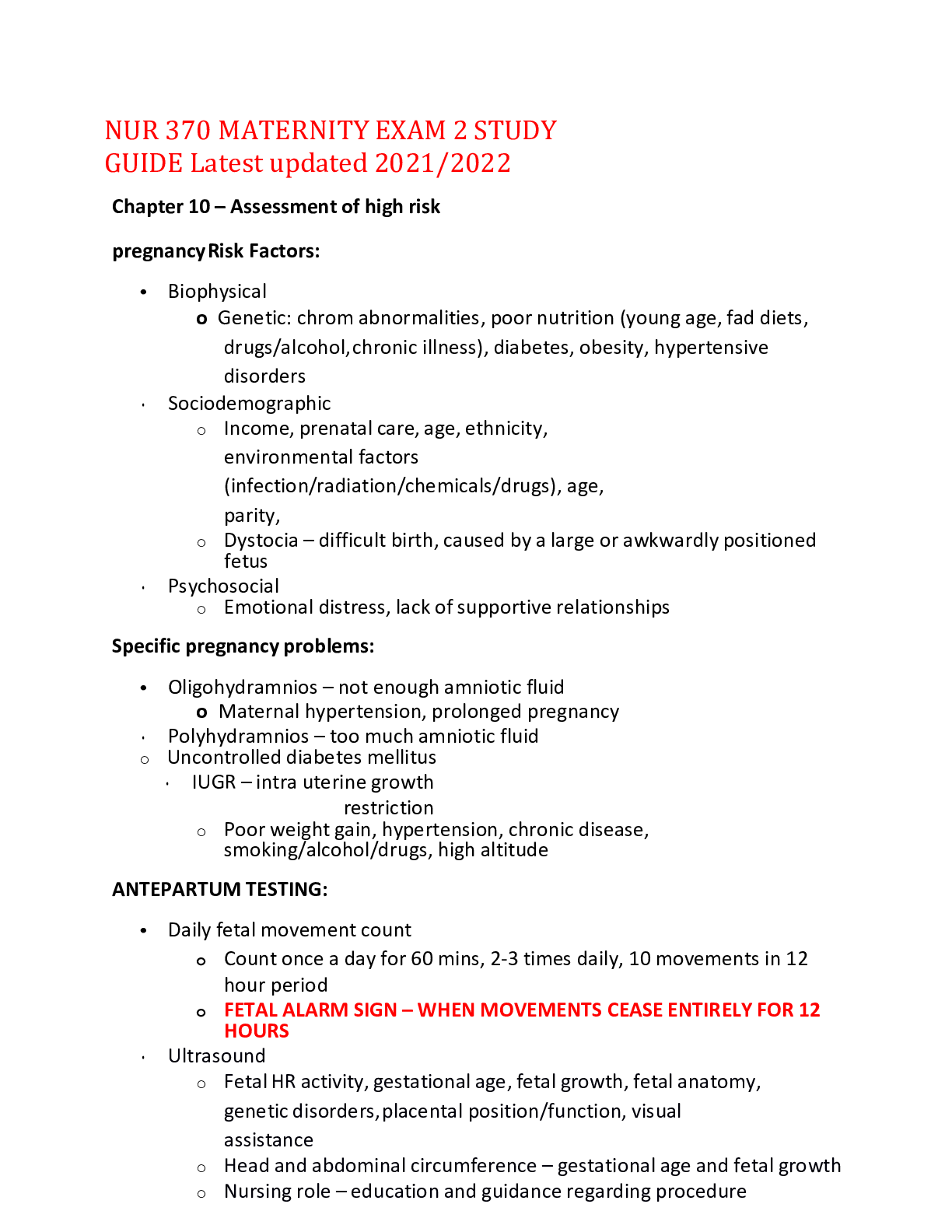
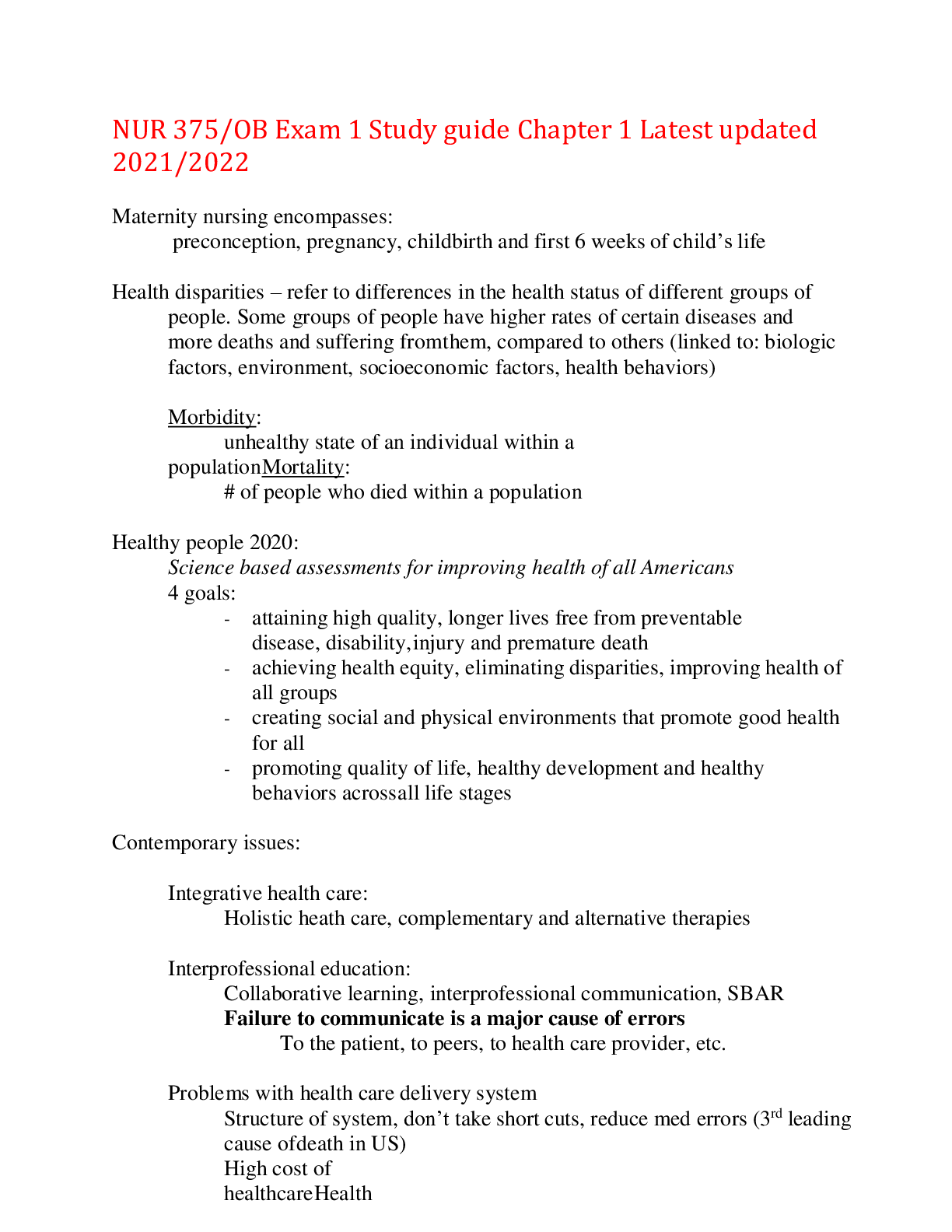
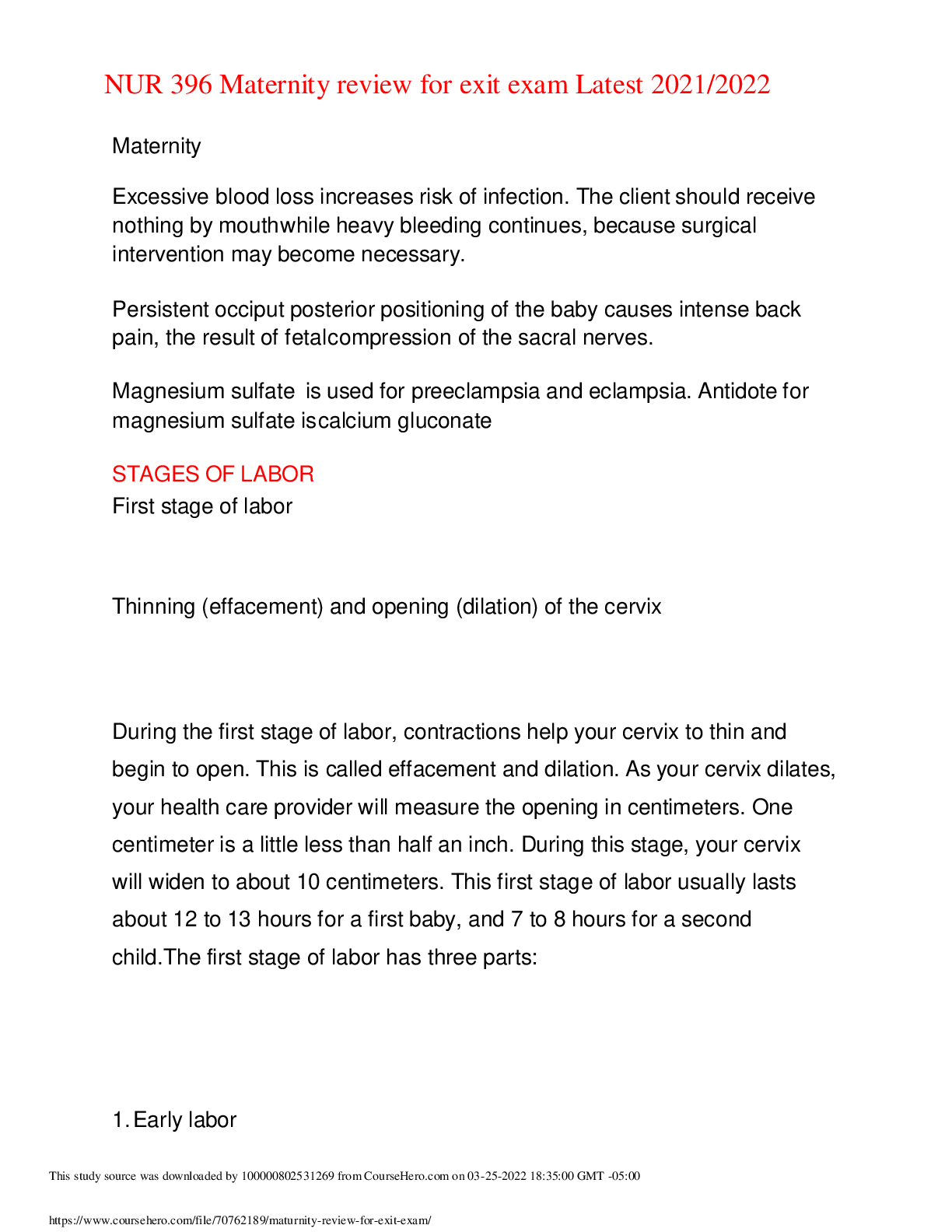
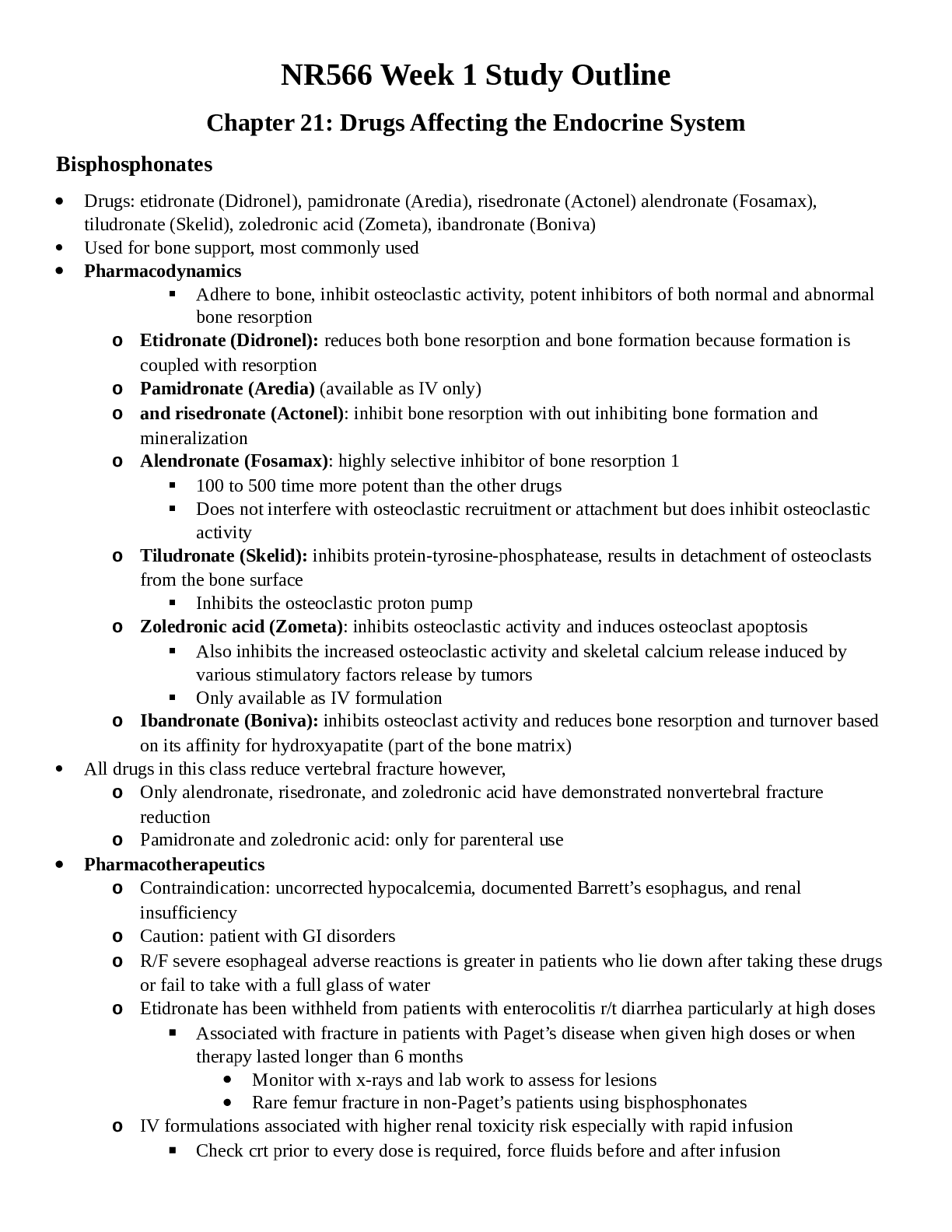
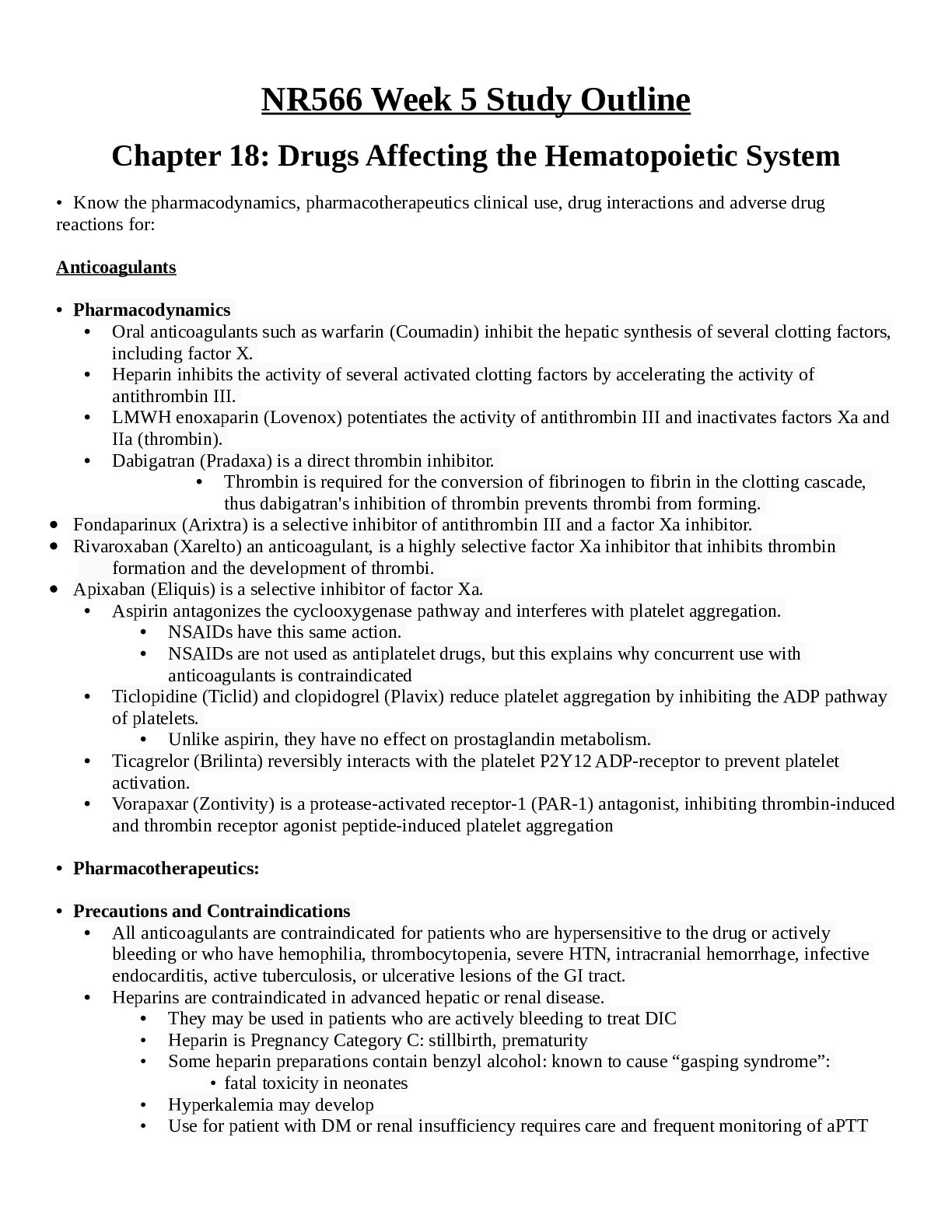
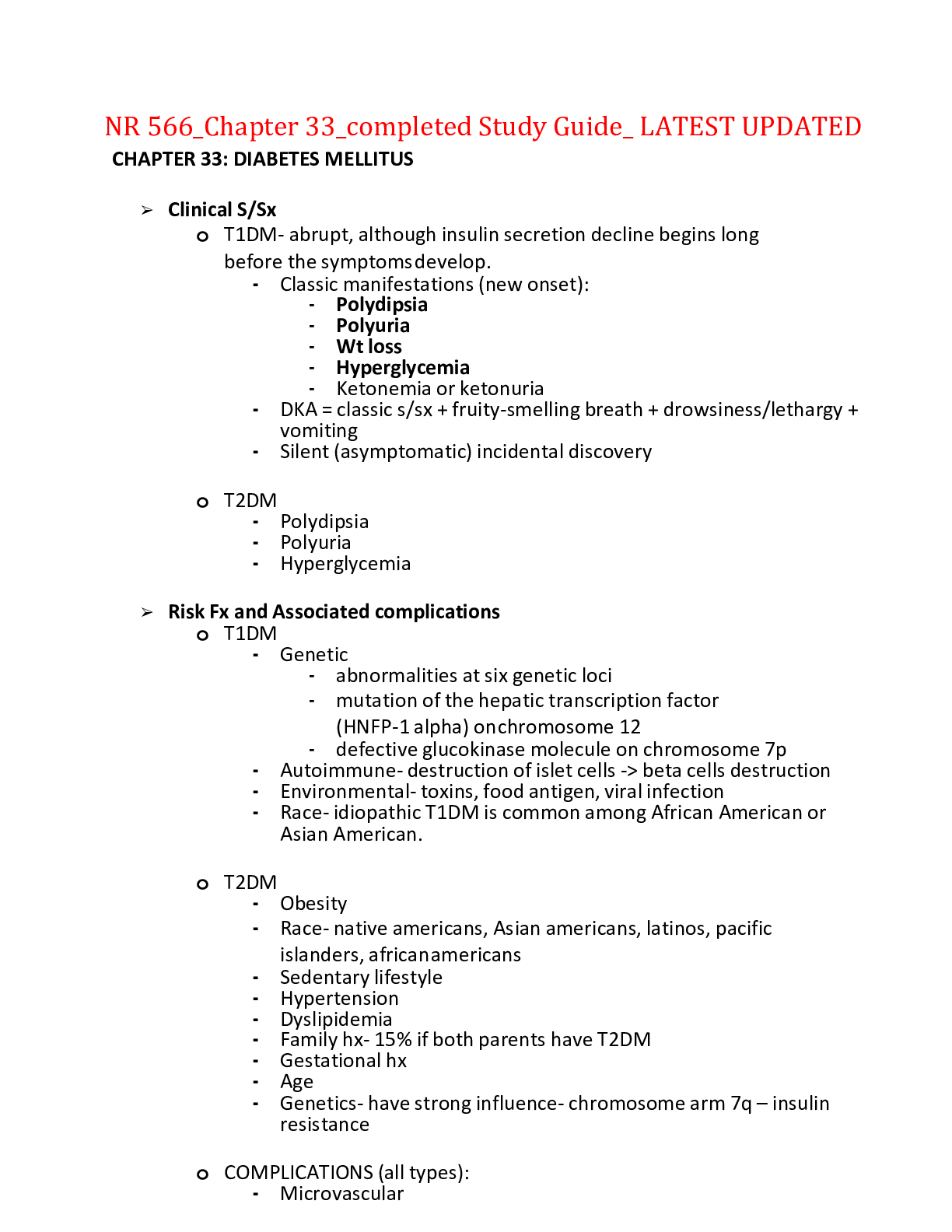
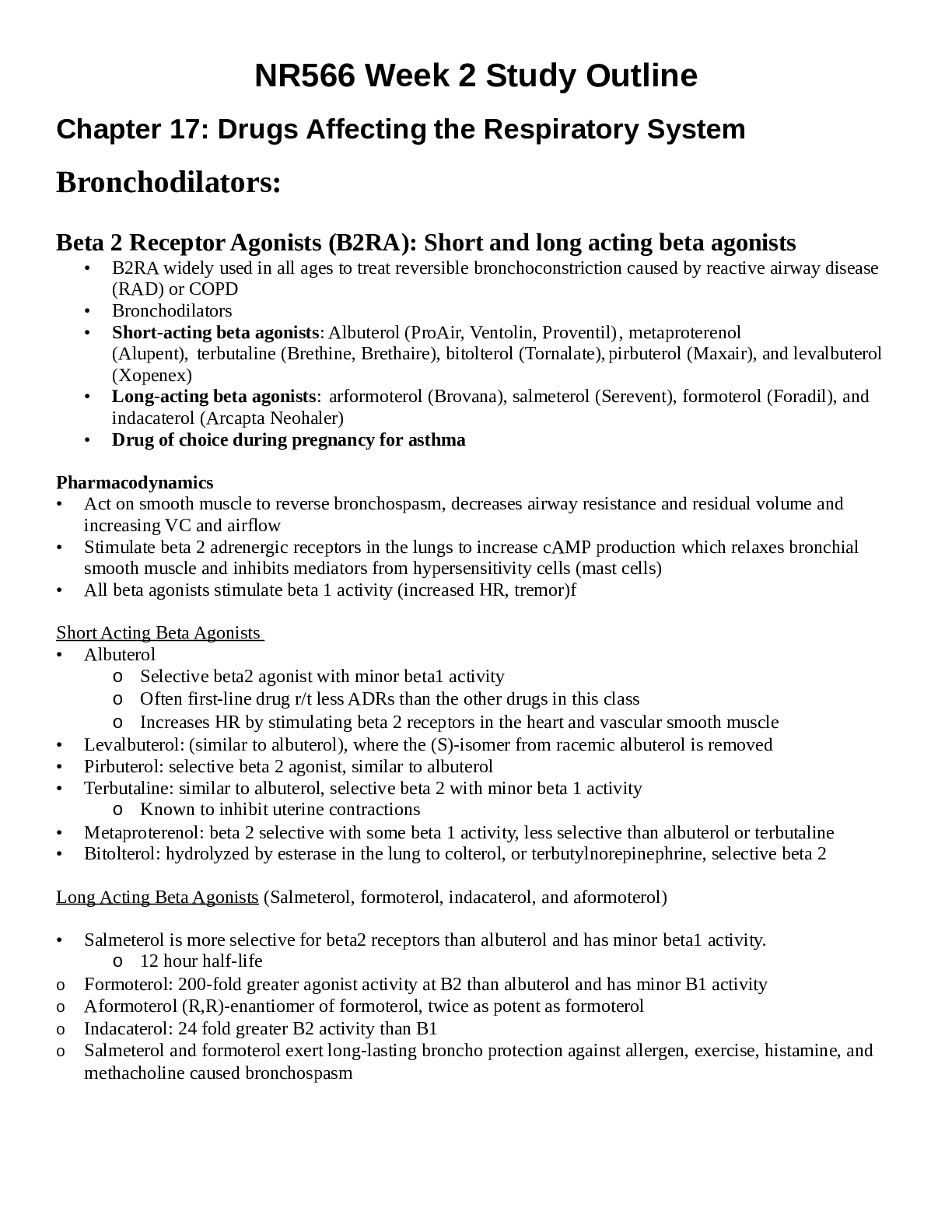
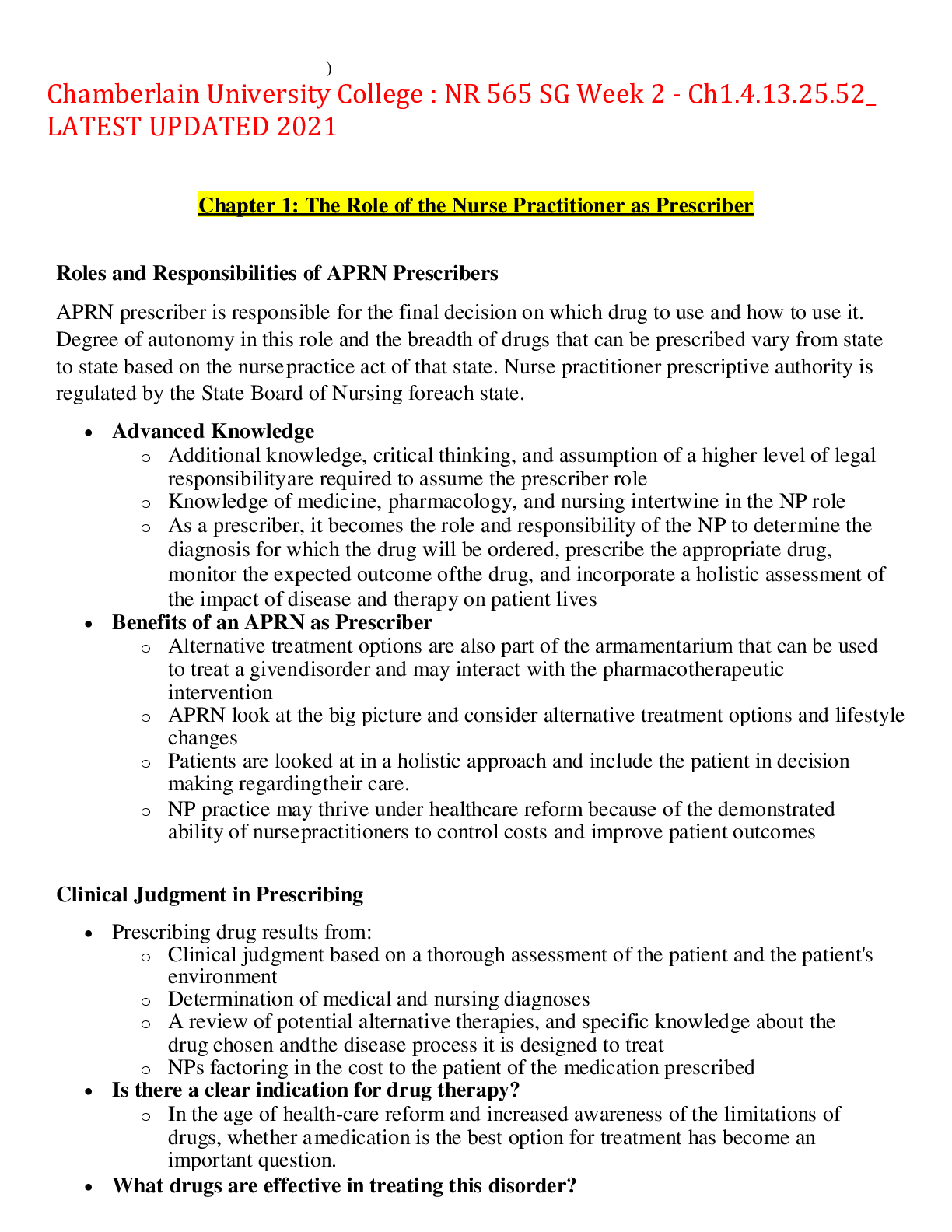


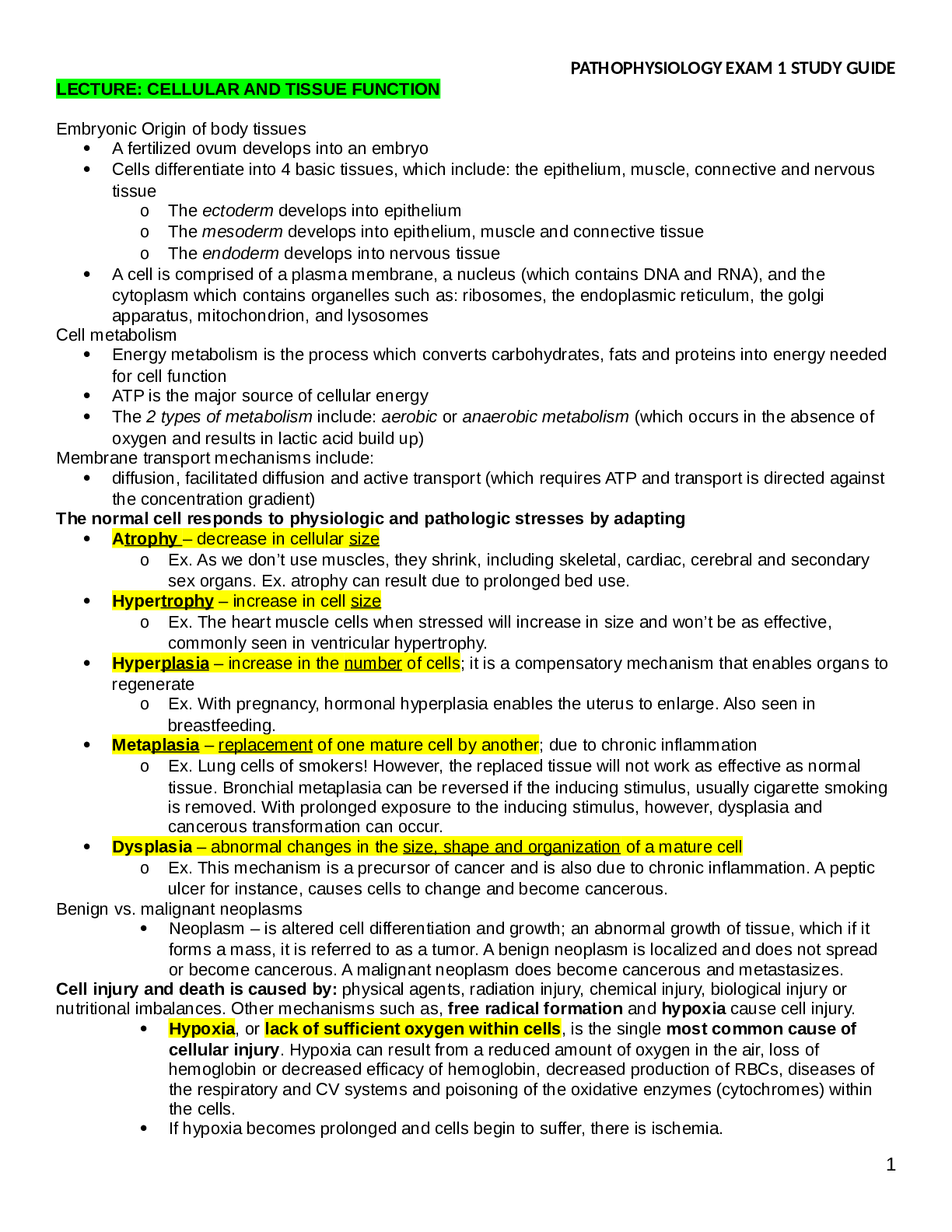
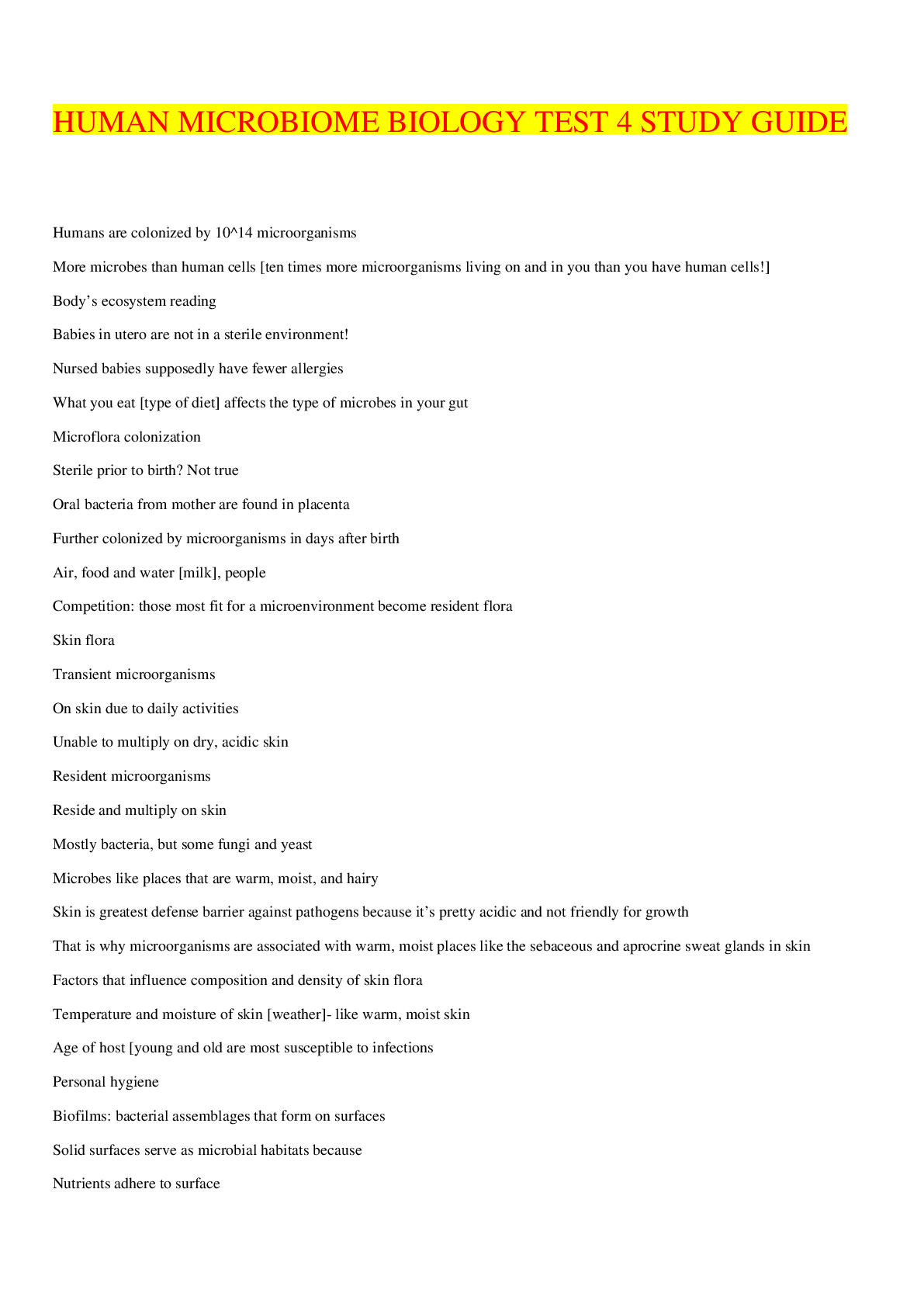

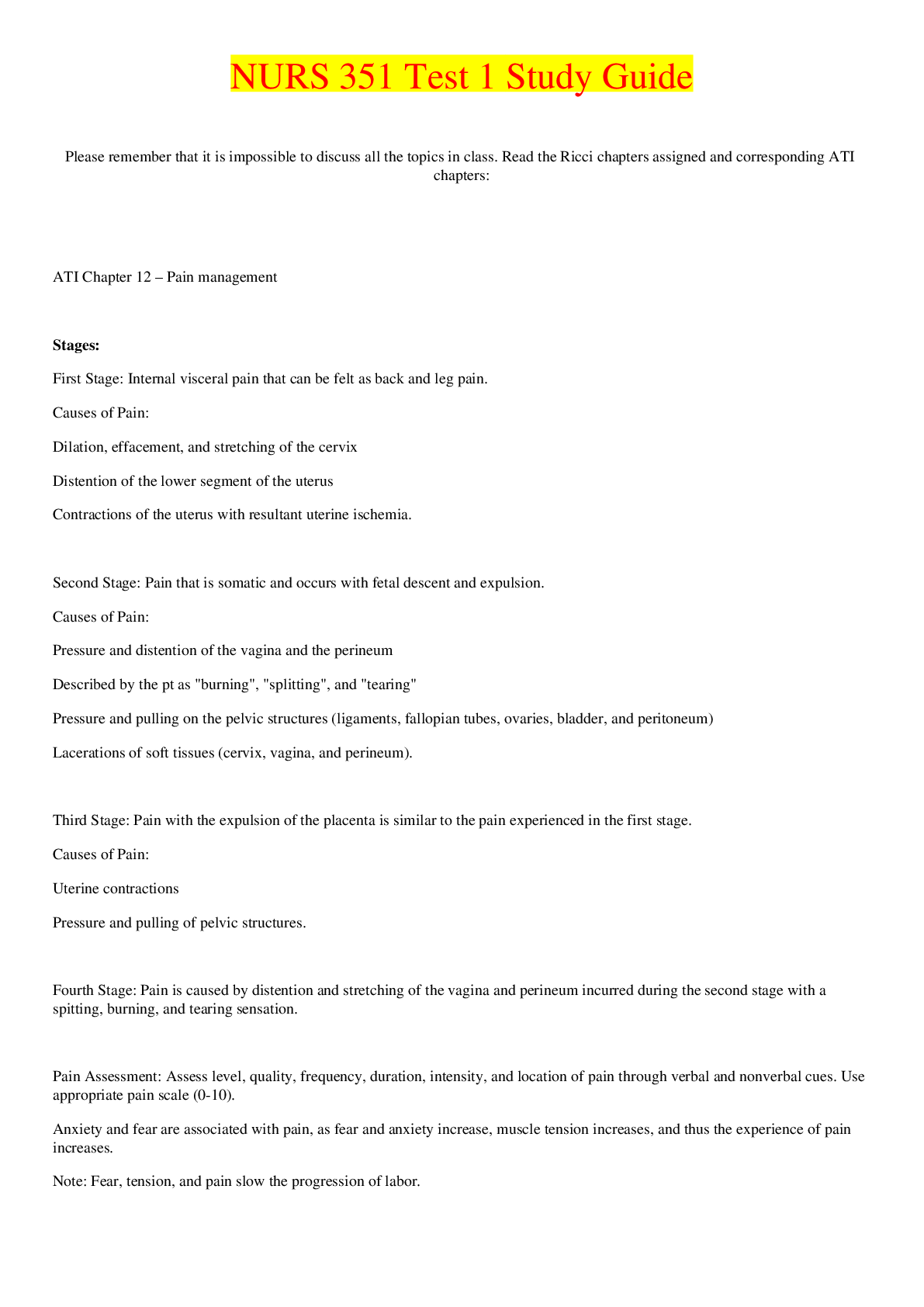
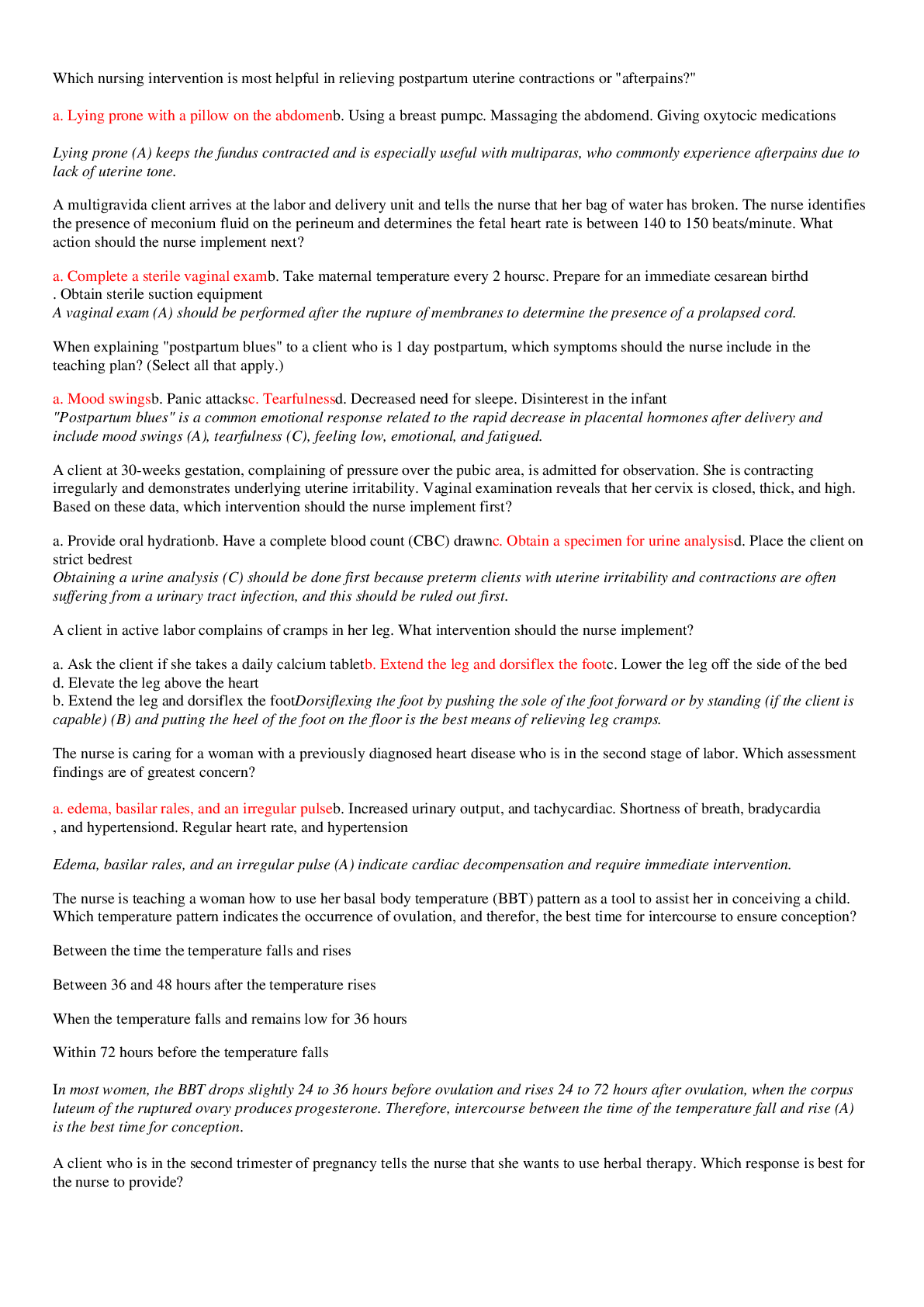
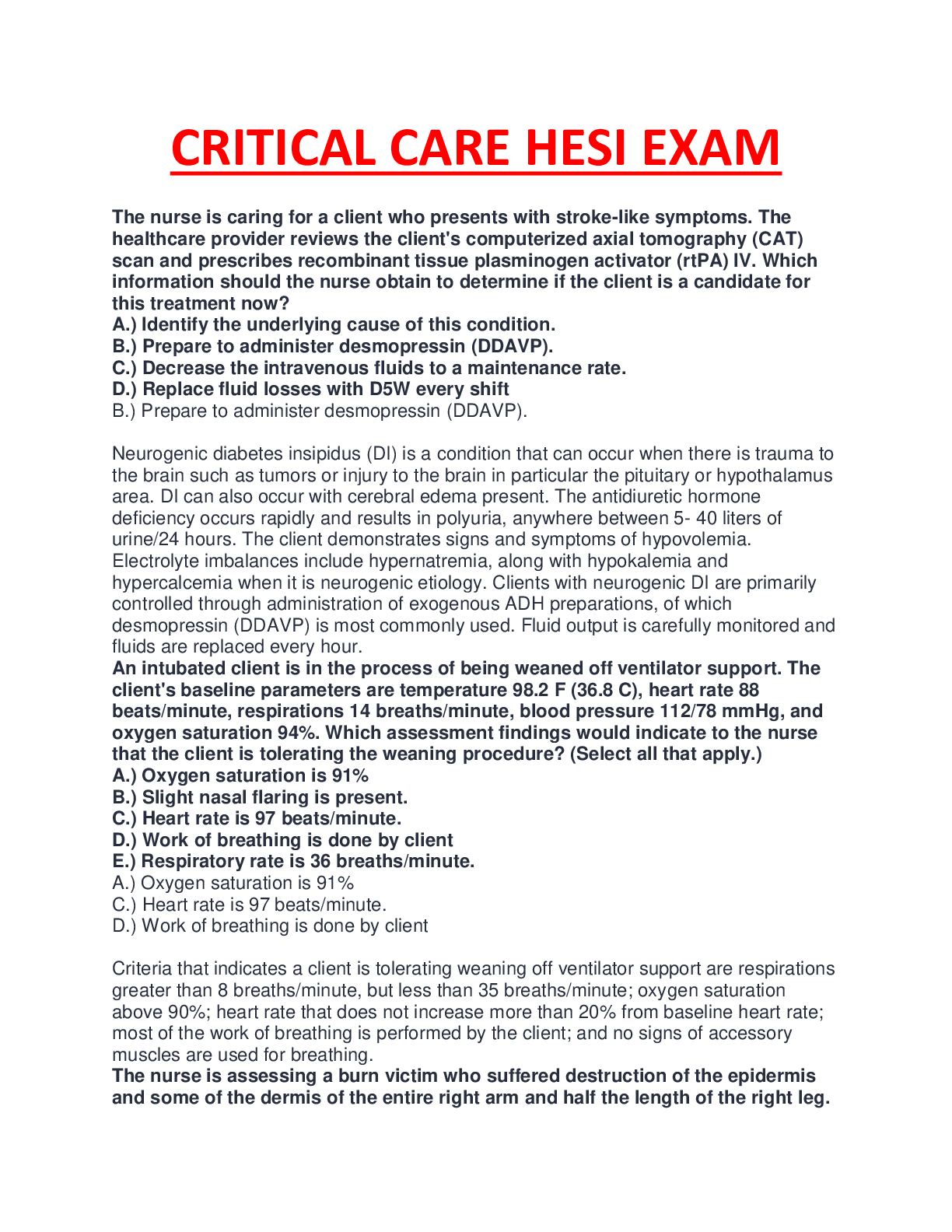


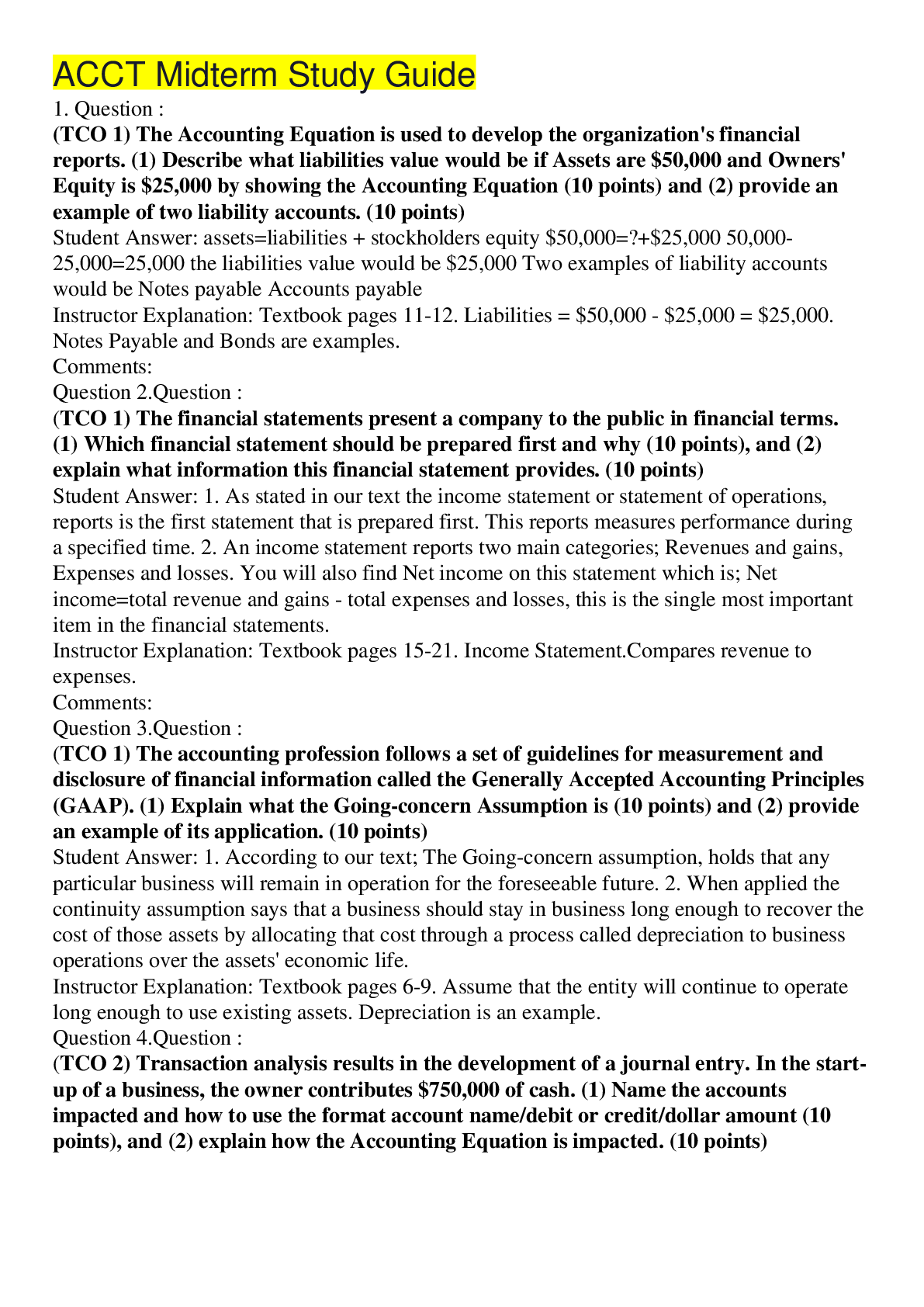

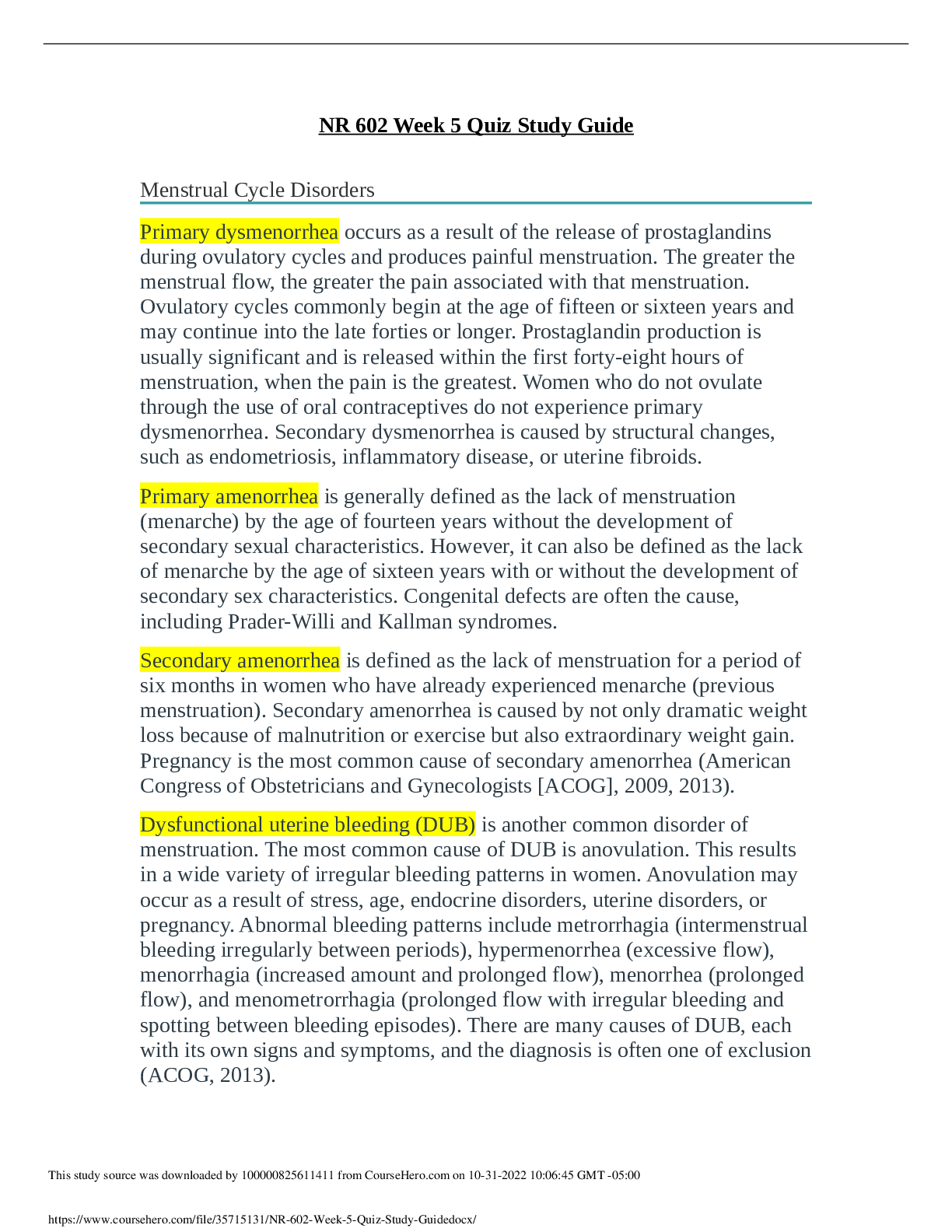


.png)

